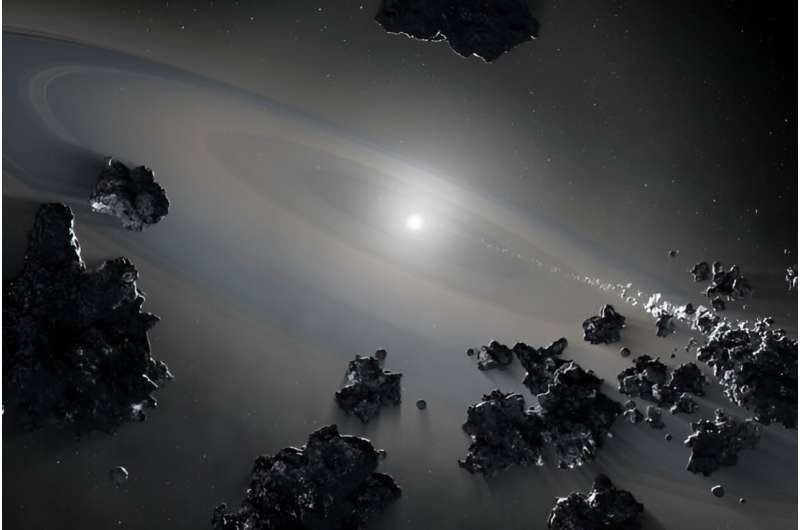
August 1, 2024 by University of Texas at Austin
Collected at: https://phys.org/news/2024-08-astronomers-ai-elusive-stars-gobbling.html
Astronomers have recently found hundreds of “polluted” white dwarf stars in our home galaxy, the Milky Way. These are white dwarfs caught actively consuming planets in their orbit. They are a valuable resource for studying the interiors of these distant, demolished planets. They are also difficult to find.
Historically, astronomers have had to manually review mountains of survey data for signs of these stars. Follow-up observations would then prove or refute their suspicions.
By using a novel form of artificial intelligence, called manifold learning, a team led by University of Texas at Austin graduate student Malia Kao has accelerated the process, leading to a 99% success rate in identification. The findings were published July 31 in The Astrophysical Journal.
White dwarfs are stars in their final stage of life. They’ve used up their fuel, released their outer layers into space and are slowly cooling. One day, our sun will become a white dwarf—but that won’t be for another 6 billion years.
Sometimes, the planets orbiting a white dwarf will be drawn in by their star’s gravity, ripped apart and consumed. When this happens, the star becomes “polluted” with heavy metals from the planet’s interior. Because white dwarfs’ atmospheres are made almost entirely of hydrogen and helium, the presence of other elements can be reliably attributed to external sources.
“For polluted white dwarfs, the inside of the planet is literally being seared onto the surface of the star for us to look at,” Kao said. “Polluted white dwarfs right now are the best way we can characterize planetary interiors.”
“Stated differently,” added Keith Hawkins, an astronomer at UT and co-author on the paper, “it’s the only bona fide way to actually figure out what planets outside the solar system are made of, which means finding these polluted white dwarfs is critical.”
Unfortunately, evidence of these stars—which are identified by the polluting metals in their atmospheres—can be subtle and hard to detect. What’s more, astronomers must find them within a relatively brief window of time.
Although astronomers can identify these stars by manually reviewing data from astronomical surveys, this can be time-intensive. To test out a faster process, the team applied AI to data available from the Gaia space telescope. “Gaia provides one of the largest spectroscopic surveys of white dwarfs to date, but the data is so low resolution that we thought it wouldn’t be possible to find polluted white dwarfs with it,” Hawkins said. “This work shows that you can.”
To find these elusive stars, the team used the AI technique called manifold learning. With it, an algorithm looks for similar features in a set of data and clumps like items together in a simplified, visual chart. Researchers can then review the chart and decide what clumps warrant further investigation.
The astronomers created an algorithm to sort over 100,000 possible white dwarfs. Of these, one clump of 375 stars looked promising: They showed the key feature of having heavy metals in their atmospheres. Follow-up observations with the Hobby-Eberly Telescope at UT’s McDonald Observatory confirmed the astronomers’ suspicions.
“Our method can increase the number of known polluted white dwarfs tenfold, allowing us to better study the diversity and geology of planets outside our solar system,” Kao said. “Ultimately, we want to determine whether life can exist outside of our solar system. If ours is unique among planetary systems, it might also be unique in its ability to sustain life.”
This innovative approach is just one example of how researchers at The University of Texas at Austin are using artificial intelligence to solve scientific mysteries. To advance and showcase these innovations, UT Austin has declared 2024 the Year of AI.
This research made use of data from the European Space Agency (ESA) mission Gaia. The data was processed by the Gaia Data Processing and Analysis Consortium.
Follow-up observations were obtained with the Hobby-Eberly Telescope (HET), which is a joint project of the University of Texas at Austin, the Pennsylvania State University, Ludwig Maximilians-Universitaet Muenchen, and Georg-August Universitaet Goettingen, and with the Very Large Telescope (VLT) at the European Southern Observatory (ESO).
The Texas Advanced Computing Center at UT Austin provided high performance computing, visualization, and storage resources for this research.
More information: Malia L. Kao et al, Hunting for Polluted White Dwarfs and Other Treasures with Gaia XP Spectra and Unsupervised Machine Learning, The Astrophysical Journal (2024). DOI: 10.3847/1538-4357/ad5d6e
Journal information: Astrophysical Journal

Leave a Reply